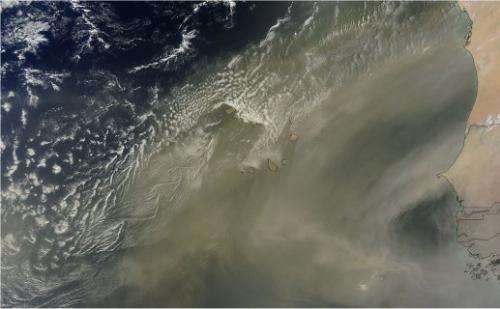Satellite images reveal that clouds affect the particles surrounding them

(Phys.org)—Call them cloud wannabes. Scientists at Pacific Northwest National Laboratory found that when the sky is described as partly cloudy, particles near those clouds swell larger with water vapor. The larger particles then reflect and scatter more sunlight energy, like cloud hopefuls. Scientists gleaned these cloud effect secrets from satellite data to find an increase of about 25 percent in the particles' reflectivity.
Aerosols are tiny particles of dust, ash, pollution, and chemical compounds suspended in the atmosphere. These small particles have huge impacts on the warming and cooling of the Earth through their power to absorb, reflect, or scatter light from the sun. Previously, global climate models have neglected the influence of clouds to increase the water attraction by these particles. This research helps scientists better understand some of the effects that have a major impact on how and when energy from the sun affects the Earth's climate.
The PNNL scientists used 11 years of high-resolution daily observations from the National Aeronautics and Space Administration (NASA) Moderate Resolution Imaging Spectroradiometer (MODIS) satellites to assess the effect of clouds on aerosols. They analyzed data on the aerosol optical thickness and fraction of the sky covered by clouds using probability density function, a statistical approach that shows the distribution of random variables. This approach enabled them to describe the relative frequency of clear sky to a sky thick with aerosol particle activity in global regions.

Although there are various factors controlling the aerosols near clouds, in their analysis the team found that hygroscopicity—the ability of the particle to attract and hold water-is a major factor driving the optical depth of particles. Satellite observations suggest that complex interactions occur between coexisting clouds and aerosol particles. This study will help improve representations of clouds in climate change, and result in a better grasp of how aerosols affect the warming and cooling effect of the sun's energy on the Earth.
PNNL researchers will use the global-scale observations for estimating how and when energy from the sun affects the Earth's climate, which will provide a better understanding of climate models.
More information: Chand D, et al. 2012. "Aerosol Optical Depth Increase in Partly Cloudy Conditions." Journal of Geophysical Research 117:D17207. DOI:10.1029/2012JD017894
Journal information: Journal of Geophysical Research
Provided by Pacific Northwest National Laboratory





















